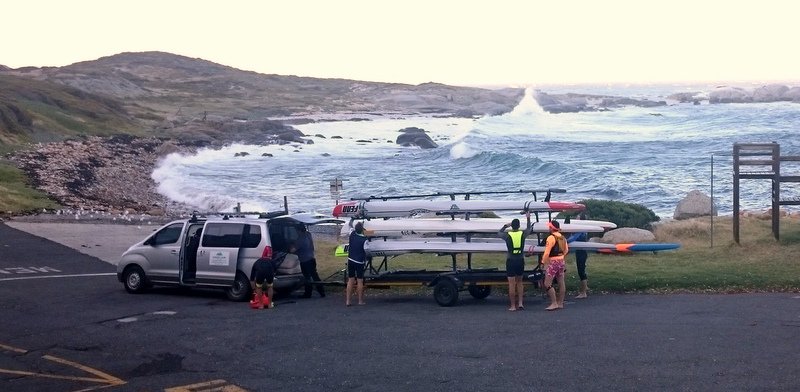
As he fell off his ski yet again, Tim Wightman felt panic starting to well up. If he didn’t get back on and paddling in the next few moments, the gale-force wind and breaking waves would drive him onto the jagged rocks of Miller’s Point. “Calm down!” he yelled to himself. “Take it slowly!” “This time, stay in the f%#$ing boat!”
Tuesday 5th December and the regular evening race in Hout Bay had been cancelled; south-easterly squalls were smashing down the sides of Chapman’s Peak and turning the surface of the bay into a churning maelstrom of whitecaps and spray.
Disappointed, Tim resigned himself to a non-paddling evening at home. But then he had a call. “Come,” his friend Gary said. “Miller’s Run!”
Wild Miller's
(The Miller’s Run is a well-known and much beloved route from Miller’s Point to Fish Hoek along the False Bay coast near Cape Town, South Africa. The most challenging section of the run is the first 800m where the paddlers have to make their way out diagonally into the wind and waves to round Bakoven Rock – which marks the start of the run.)
Tim takes up the story:
“I've been paddling regularly once a week from Three Anchor Bay in Cape Town, but it's been a couple of years since I last did a Miller’s Run,” he said. “The wind was gusting up to 35kts, so there I felt some trepidation, but I pulled the trigger and drove out to Fish Hoek, loaded up onto the Miller's Taxi with Gary and a couple of others.”
The Miller's Run Taxi has made the route much more accessible
The view from the Miller’s Point slipway wasn’t encouraging. As he looked out towards Bakoven Rock, Tim thought it looked, “like an absolute washing machine, with large waves almost breaking all the way out. Coupled with the powerful gusting wind, conditions were going to be testing.”
Rudder Damage
Nervous, he rushed his launch off the slipway, and his rudder grated along the concrete. He didn’t give it a second thought at the time but the impact had bent the shaft, compromising the movement of the rudder.
Not realising what had happened, he paddled out into the storm. The difficulty of paddling diagonally into the wind was compounded by the bigger waves beyond the mouth of the bay. As he crested the swells, the nose of his ski was flung sideways by the wind; once too often and he tipped into the icy water.
“In such conditions, things go pear-shaped pretty quickly,” he said. “It takes some fair amount of energy and concentration to re-mount in gale force conditions and large swell. Add cold to the mix, and a dash of panic with a row of sharp rocks nearby, and it's a recipe for disaster...
“I managed to get things together a couple of times but couldn't seem to control the rudder which was very frustrating. I fell in a few more times, my leg leash getting tangled around the boat and my other leg, making things even more tricky. With each dismount and re-mount my energy dropped lower and my panic levels rose. I had to shout to myself a few times to calm down…”
